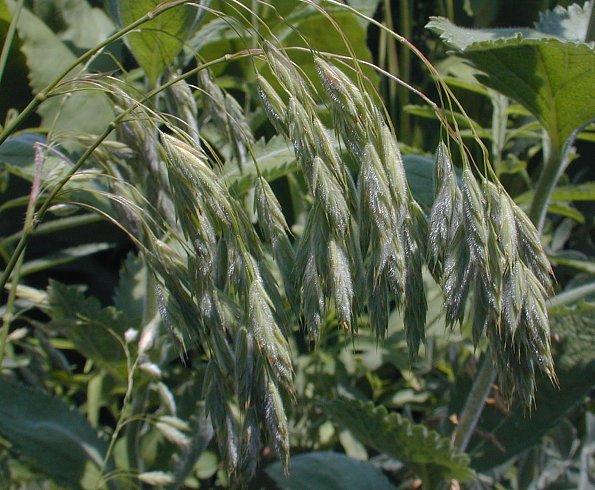Plants perennial; not rhizomatous. Culms 50-100(110) cm, usually erect, sometimes decumbent at the base; nodes 3-5, pubescent, puberulent, or glabrous; internodes puberulent or glabrous. Sheaths and throats pilose or glabrous; auricles absent; ligules 0.5-1 mm, glabrous, truncate, erose; blades 10-17 cm long, 5-10 mm wide, flat, with prow-shaped tips, both surfaces glabrous or pilose or only the adaxial surfaces pilose. Panicles 8-13 cm, open, drooping; branches ascending to spreading, flexuous. Spikelets 15-25 mm, elliptic to lanceolate, terete to moderately laterally compressed, with 7-11 florets. Glumes pubescent, margins often hyaline; lower glumes 5-7.5 mm, 3-veined; upper glumes 6.5-8.5 mm, 5-veined; lemmas 7-11 mm, elliptic to lanceolate, rounded over the midvein, backs more or less uniformly pilose or pubescent, margins densely long-pilose, apices acute to obtuse, entire; awns 1.5-3 mm, straight, arising less than 1.5 mm below the lemma apices; anthers 1.5-2.5 mm. 2n = 14.
Bromus kalmii grows in sandy, gravelly, or limestone soils in open woods and calcareous fens. Its range centers in the north-central and northeastern United States and adjacent Canadian provinces.
Infrequent on low, open dunes and in marshy and springy places in the lake region. [Deam also recognizes B. purgans and notes that it is:] infrequent to frequent throughout the state in dry places, rarely in wet places, in black and white oak woods and less frequent in beech and sugar maple woods.
Perennial 5-10 dm, the culms loosely clustered or solitary, mostly glabrous except for the often hairy nodes; lvs mostly 3-6 per stem, the nodes mostly exposed; sheaths villous to occasionally glabrous; blades 1-2 dm נ5-10 mm, glabrous or hairy; ligule under 1 mm; infl nodding, 5-10 cm, the relatively few spikelets drooping on slender flexuous pedicels; spikelets 15-25 mm, 6-11-fld, softly villous; first glume 6-7 mm; 3-veined, the second 7-9 mm, 5-veined; lemmas 8-10 mm, 7-veined, obtuse, the awn 2-3 mm, the short lemma-teeth a third as wide as long; 2n=14. Dry woods, rocky banks, and sandy soil; Me. to Minn. and S.D., s. to Md. and Io.
Gleason, Henry A. & Cronquist, Arthur J. 1991. Manual of vascular plants of northeastern United States and adjacent Canada. lxxv + 910 pp.
©The New York Botanical Garden. All rights reserved. Used by permission.







